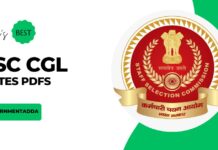 For Daily Job Alert For Daily Job Alert |
Join Our Whats App Channel |
 For Free Study Material For Free Study Material |
Join Our Telegram Channel |
General Awareness play a vital role in all Examination. we can expect Questions from different Topics.Here we have given Study Notes on ” Primary and Secondary data ” Paper-III (Statistics) for SSC CGL Examinations 2019-20. Candidates those who are all preparing for the Examination can use this study material.
Data is a tool which helps in reaching a sound conclusion by providing information therefore. For statistical investigation, collection of data is the first and foremost.
PRESENTATION OF DATA
Raw data : When the data is compiled in the same form and order in which it is collected, it is known as Raw data.
The difference of the highest and the lowest values in the data is called the range of the data.
Frequency : It is a number, which tells that how many times does a particular data appear in a given set of data.
Frequency Distribution :
A tabular arrangement of data showing their corresponding frequencies is called a frequency distribution.
Descrete frequency distribution :
When number of terms is large and variate are descrete, variate can accept some particular values only under finite limits and is repeated then it is called descrete frequency distribution.
Continuous frequency distribution :
When number of terms is large and variate is continuous, i.e., variate can accept all values under finite limits and they are repeated then it is called continuous frequency distribution.
GRAPHICAL REPRESENTATION OF DATA
The representation of data through diagrams helps us to visualize the Whole meaning of a numerical distribution at a single glance. There are various methods of representing the data by means of graphs.
(A) Bar graphs
(B) Histograms of uniform width, and of varying widths
(C) Frequency polygons
Sources of Data
For the study purpose both primary and secondary data are used. The primary data collected from sales men of the companies, customers and dealers dealing in the products of the company. The secondary data collected from records of the company, retailers and dealers.
The data of past sales also have been collected. The primary and secondary data have been collected to cover every aspect of the study. The primary data are related to behaviour and response of employees, dealers and customers. The secondary data shows the sales of the company product wise. These data used in combination as per need of the study. These data having different merits and demerits and have serves our purpose of the research study.
These are explained below:
1. Primary Source
2. Secondary Sources
a. Published sources
b. Un-published sources
Primary Data
Primary data are information collected by a researcher specifically for a research assignment. In other words, primary data are information that a company must gather because no one has compiled and published the information in a forum accessible to the public. Companies generally take the time and allocate the resources required to gather primary data only when a question, issue or problem presents itself that is sufficiently important or unique that it warrants the expenditure necessary to gather the primary data.
Primary data are original in nature and directly related to the issue or problem and current data.
Primary data are the data which the researcher collects through various methods like interviews, surveys, questionnaires etc.
Methods of collecting primary data
There are three basic ways of collecting data :
(i) Personal interview OR Direct Personal Investigation
(ii) Mailing (questionnaire surveys)
(iii) Telephone interviews
(iv) Indirect verbal investigation
(v) Information from local sources
(vi) Enumerator method
Secondary Data
Secondary data are the data collected by a party not related to the research study but collected these data for some other purpose and at different time in the past. If the researcher uses these data then these become secondary data for the current users.
These may be available in written, typed or in electronic forms.
A variety of secondary information sources is available to the researcher gathering data on an industry, potential product applications and the market place. Secondary data is also used to gain initial insight into the research problem. Secondary data is classified in terms of its source – either internal or external. Internal, or in-house data, is secondary information acquired within the organization where research is being carried out. External secondary data is obtained from outside sources.
Sources of secondary data
1. Govt. publication
2. semi-Govt. Publication
3. Reports of committees & commissions
4. Private publications e.g., Journals and News papers research institute, publication of trade association.
5. International publications
Point of difference between Primary and Secondary data
| BASIS FOR COMPARISON |
PRIMARY DATA | SECONDARY DATA |
| Meaning | Primary data refer to the first hand data gathered by the researcher himself. | Secondary data means data collected by someone else earlier. |
| Data | Real time data | Past data |
| Process | Very involved | Quick and easy |
| Source | Surveys, observations, experiments, questionnaire, personal interview, etc. | Government publications, websites, books, journal articles, internal records etc. |
| Cost effectiveness | Expensive | Economical |
| Collection time | Long | Short |
| Specific | Always specific to the researcher’s needs. | May or may not be specific to the researcher’s need. |
| Accuracy and Reliability | More | Relatively less |













